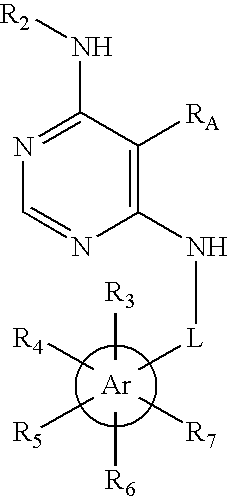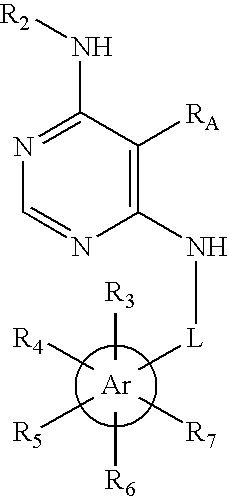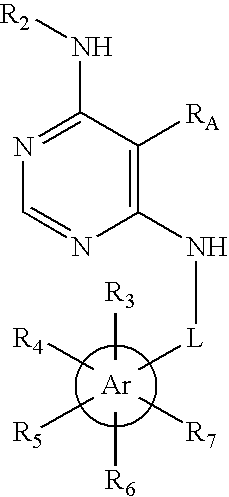Substituted pyrimidinyl oxime kinase inhibitors
a technology of pyrimidinyl oxime kinase and substituted pyrimidine, which is applied in the direction of biocide, drug composition, metabolic disorder, etc., can solve the problems of uncontrollable cell proliferation, poor prognosis of patients, and especially likely to affect the muscles of the face or upper trunk
- Summary
- Abstract
- Description
- Claims
- Application Information
AI Technical Summary
Benefits of technology
Problems solved by technology
Method used
Image
Examples
example 1
[0444]The EGFR kinase used was a fusion of Glutathione-S-Transferase (GST) and a PCR amplified intracellular portion of EGFR (NM—005228). The intracellular portion of EGFR started at nucleotide 2189 (corresponding to amino acid 667) and ended at the termination codon. The portion was PCR amplified with primers that added the lambda attB sequences to each end, recombined into an entry vector, then into a GST destination vector (as described in Gateway Technologies Manual by Invitrogen Corporation, Carlsbad, Calif.).
[0445]The destination vector was recombined in the DH10BAC strain of bacteria to produce a bacmid. The bacmid was transfected into Sf 9 cells and the supernatant containing the baculovirus was collected. The GSTEGFR protein was purified using large cultures of Sf 9 cells infected with stock virus. After an appropriate period of time, the cells were collected and lysed. The GSTEGFR was then purified from the lysate on Glutathione-Sepharose columns (as descr...
example 2
[0454]The HER-2 kinase used was purified at Proqinase (Freiburg, Germany) from a construct that consisted of a fusion of GST (Glutathione-S-Transferase), HIS6-Thrombin and the nucleotides encoding amino acids 679 to 1255 of HER-2 (Accession Number M11730).
[0455]A mixture of a 10× kinase reaction buffer (600 mM Hepes at pH 7.5, 30 mM Magnesium Chloride, 0.03 mM Sodium Vanadate and 500 μg / mL PEG 20,000), DTT (1.2 mM final from a 10 mM stock), ATP (1 μM from a 10 mM stock), biotinylated polyGluTyr (1.5 ng / μL final from stock of 1 μg / μL) prepared by Upstate Biotechnologies, Lake Placid, N.Y.), Manganese Chloride (3 mM final from a 1 M stock), γ-33P-ATP (10 μCi / μL stock) and water (70 μL / well) was added to each well of a Streptavidin Flashplate (Cat. #SMP103, NEN, Boston, Mass.).
[0456]Test compound stock (1 μL) was added to the appropriate wells. Diluted GSTHER2 kinase (6.7 ng / μL diluted into 50 mM Tris-HCl at pH 8.0 and 0.1% bovine serum albumin) (30 μL) was added (tot...
example 3
In Vitro Cell Proliferation Inhibition Assays
[0462]The ability of a test compound to inhibit unregulated in vitro cell proliferation may be determined by measuring incorporation of 14C-labelled thymidine into newly synthesized DNA within cell lines derived from carcinomas originating from several tissues. Accordingly, the effect of a test compound on proliferation of cells with a variety of phenotypes may be determined.
[0463]Carcinoma cell lines used include the HeLa cervical adenocarcinoma from the American Type Culture Collection (ATCC Cat. #CCL2), SK-OV-3 ovarian carcinoma (ATCC Cat. #HTB-77), MCF-7 breast carcinoma (ATCC Cat. #HTB-22), BT474 breast carcinoma (ATCC Cat. #HTB-20), SKBR3 breast carcinoma (ATCC Cat. #HTB-30), A431 epidermoid carcinoma (ATCC Cat. #CRL-1555) and NCI-N87 gastric carcinoma (ATCC Cat. #CRL-5822).
[0464]The carcinoma cells are trypsinized and counted. The cells (3000-8000 count) are added to each well of a 96-well CytoStar tissue culture treated scintillat...
PUM
| Property | Measurement | Unit |
|---|---|---|
| weight | aaaaa | aaaaa |
| temperature | aaaaa | aaaaa |
| time | aaaaa | aaaaa |
Abstract
Description
Claims
Application Information
 Login to View More
Login to View More - R&D
- Intellectual Property
- Life Sciences
- Materials
- Tech Scout
- Unparalleled Data Quality
- Higher Quality Content
- 60% Fewer Hallucinations
Browse by: Latest US Patents, China's latest patents, Technical Efficacy Thesaurus, Application Domain, Technology Topic, Popular Technical Reports.
© 2025 PatSnap. All rights reserved.Legal|Privacy policy|Modern Slavery Act Transparency Statement|Sitemap|About US| Contact US: help@patsnap.com



